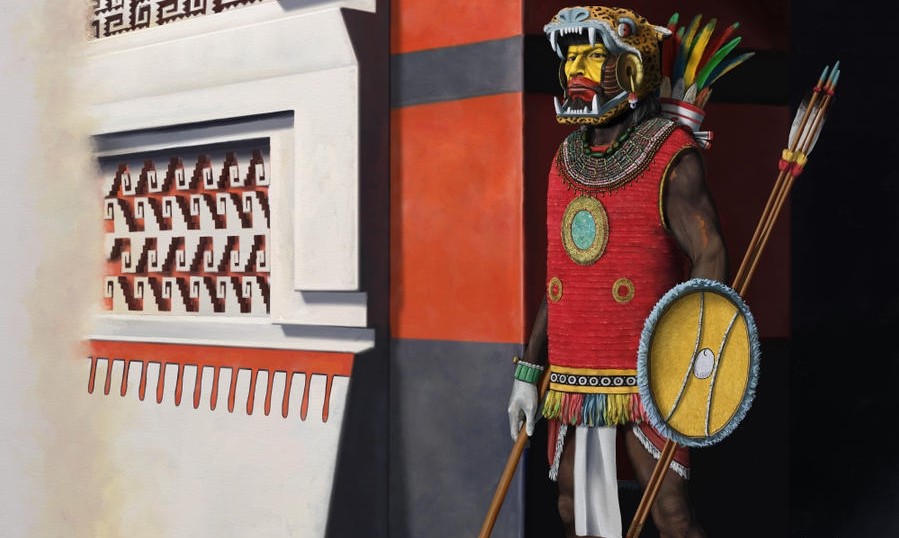Tlahuiztli
by hughpierre
Tlahuiztli are war costumes consisting of long sleeves and leggings awarded to various ranks of the military. Every rank wears different colored and decorated tlahuiztli to make them easily distinguished on the battlefield along with pamitl or other military emblems.
Mechanics & Inner Workings
The distinctively decorated suits of the four major militaries groups. Usually made to work as a single piece of clothing with an opening in the back. They cover the entire torso and most extremities of a warrior to offer added protection to the wearer. Tlahuiztli suits are most effective when worn as a pullover that hugs the ichcahuipilli and further covers all the way to the thigh.
Cuacalalatli
A war helmet carved of amate paper, orchid glue, bone or hardwood like mahogany. The helmet is equipped with a heavy, double-glazed cotton wool fastened under the chin with a cloth leash. They are awarded to soldiers by the state and shaped to represent different animals like howler monkeys, predatory cats, birds, coyotes, or the odd deity. These helmets protect most of a warriors head from the crown to the jawline and where the warrior sees through the animal's open jaw, however, it is not impenetrable. They are decorated according to the wearer's tlahuiztli, but high-ranking aristocrats order a variety of helmets to include eagles, parrots and deer.Pāmitl
The identifying emblems that officers and members of prestigious warrior societies wore on their backs. These are frequently unique to their wearers, and are meant to identify the warrior at a distance. These banners also allow officers to coordinate unit movement. They are made of amate paper spread over frames of reed and ixtle.Manufacturing process
- Fluffed up cotton is soaked in salt water and allowed to dry.
- The respun cotton is sewed between two layers of cloth.
- A leather border is stitched around the edges.
- Afterwards, the outward facing side is painted and richly ornamented to the owners' desires with many dyes and coloured feathers.
The strength of their feather-covered garments are proportional to their weapons. So you can tell at a glance, how well they will resist your spears, arrows, or sword.
Significance
These suits served as a way to identify warriors according to their achievements in battle as well as rank, alliance, and social status like priesthood or nobility. Tlahuiztli are often reserved for the nobles or elite warriors. Eagle and Jaguar warriors customize theirs with eagle feathers or jaguar hides.
Ranking above these came the nobles of the warrior societies. These are ranked according to the number of captives they had taken in previous battles. The number of captives determined which of the different suits of honour they are allowed to wear, which correlate to allowing them certain rights like:
- Being able to wear sandals and jewelry
- Altering their hairstyles
- Wearing warpaint
- Carrying flowers onto the battlefield
- Piercing ornaments onto their ears, lips or labrets
- Tattooing depictions of the gods and marks of strength on themselves
Nahualismo
Tlahuiztli clothing is not culturally thought of as an armor, rather as ritual clothing. The Sang believe that it provides magical protection through means of the spirit of some animal, god or monster possessing the tlahuiztli's wearer to grant the powers of the jaguar, eagle, coyote or tzitzimitl the suit represents. The tradition of this suit is in memory of the knowledge lost during the great exodus from when warriors wore shadow skins to maul their enemies.Ochpaniztli
A yearly event where provincial tlatoani handout this dress as part of tlacochcalcatl promotions. During the sweeping festival; brave and worthy warriors, who had given military service as tribute to Sangsalgu Proper, have a special period where they poster in front the citizenry. They are publicly honoured through feasts. dances and some assigned more prestigious positions as part of the wider state bureaucracy.
Item type
Armor
Current Location
Subtype / Model
Related Technologies
Owning Organization
Rarity
Limited to prestigious warrior societies
Raw materials & Components
- Animal Hides
- Leather
- Cotton or linen fabric
- Feathers
- Bone
Related Materials




Comments